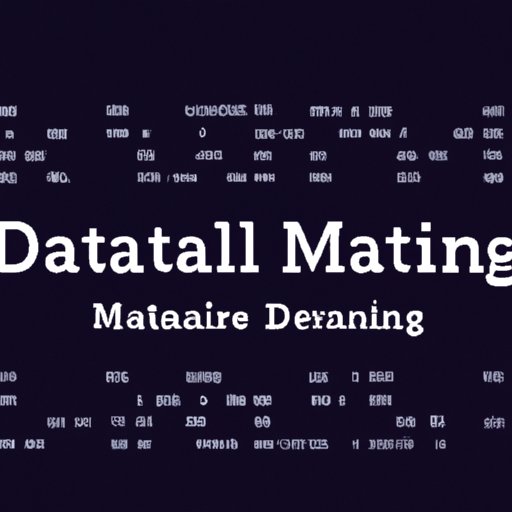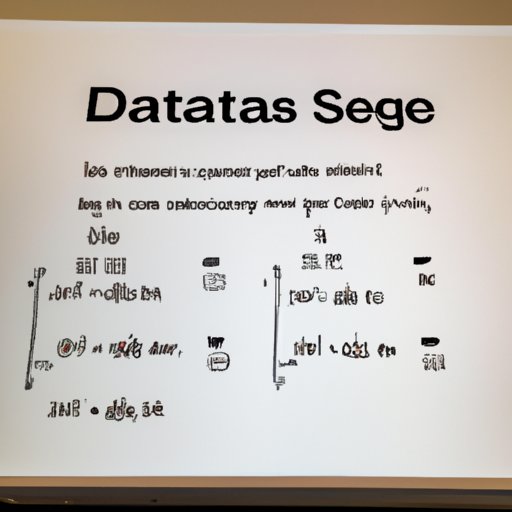Introduction
Data science is a rapidly growing field that combines elements from computer science, mathematics, and statistics to analyze large datasets. It is used to uncover patterns, trends, and insights from data, which can then be used to make decisions and predictions. Mathematics, on the other hand, is a field of study concerned with numbers, shapes, and relationships between them. Although the two fields may appear unrelated at first glance, there is an undeniable intersection between data science and mathematics.

Exploring the Role of Mathematics in Data Science
Mathematics plays a critical role in data science, both in terms of understanding the underlying principles of the field and in applying those principles to real-world problems. By understanding the mathematical concepts used in data science, analysts can better interpret the results of their analyses. For example, understanding the fundamentals of linear algebra and calculus can help analysts understand the meaning of the coefficients in regression models.
In addition to understanding mathematical concepts, data scientists must also be familiar with algorithms, which are sets of instructions used to solve specific problems. Algorithms are essential for data analysis, as they enable data scientists to quickly process large amounts of data and draw meaningful conclusions. Popular algorithms used in data science include decision trees, random forests, and k-means clustering.
Statistics is another important component of data science. Statistical methods such as hypothesis testing and regression analysis provide data scientists with powerful tools for analyzing data and drawing meaningful conclusions. By understanding the basics of probability and statistical inference, data scientists can better interpret the results of their analyses.
A Comprehensive Overview of Data Science in Mathematics
Linear algebra and calculus are two of the most fundamental branches of mathematics, and they play a key role in data science. Linear algebra is used to represent data in matrix form and solve linear equations, while calculus is used to calculate derivatives and optimize functions. Together, these two branches of mathematics provide data scientists with the tools they need to understand and manipulate data.
In addition to linear algebra and calculus, probability and its associated concepts are essential for data science. Probability theory enables data scientists to understand the likelihood of certain events occurring, while Bayesian statistics provides a framework for incorporating prior knowledge into data analysis. Understanding probability is essential for interpreting the results of data analysis and making informed decisions.
Finally, optimization techniques are important for data science. By using optimization algorithms, data scientists can find the optimal solution to a given problem, such as finding the shortest route between two locations or determining the most efficient way to allocate resources. Optimization techniques are also used to develop machine learning models, which are used to automate data analysis tasks.

An Introduction to Data Science Through Mathematics
Data science is a complex field that requires knowledge of a wide range of topics. Understanding the fundamentals of data science is essential for becoming a successful data scientist. This includes topics such as data cleaning, data wrangling, data visualization, and data analysis.
Data analysis is one of the most important aspects of data science. By using various techniques such as regression analysis and hypothesis testing, data scientists can uncover patterns and trends in data that can be used to make predictions and decisions. Machine learning is another important aspect of data science, as it enables data scientists to automate data analysis tasks.
Analyzing How Mathematical Concepts are Applied in Data Science
Numerical methods are often used to solve complex problems in data science. These methods include numerical integration, numerical differentiation, and numerical optimization, among others. Numerical methods are used to approximate solutions to difficult problems, such as finding the best route between two cities or optimizing machine learning models.
Graph theory is another branch of mathematics that is used in data science. Graphs are used to represent data in a visual format, which can help data scientists identify patterns and insights from data. Graphs can also be used to model complex systems, such as social networks, and analyze their behavior.
Optimization techniques are also used in data science. By using optimization algorithms, data scientists can find the optimal solution to a given problem, such as minimizing the cost of production or maximizing profits. Optimization techniques are also used to develop machine learning models, which are used to automate data analysis tasks.
Unveiling the Power of Data Science Through Mathematics
Data science has the potential to revolutionize the way we think about mathematics. By combining the power of data analysis and mathematical modeling, data scientists can uncover new insights and uncover previously hidden patterns. Furthermore, data science can be used to improve existing mathematical models, by incorporating more sophisticated algorithms and methods.
Data visualization is also an important part of data science. By using visual representations of data, data scientists can better understand the underlying patterns and trends in data. Data visualization can also help uncover previously hidden insights, as well as help communicate complex ideas to a wider audience.
Finally, artificial intelligence (AI) is a powerful tool that can be used to automate data analysis tasks. AI algorithms can be used to detect patterns and anomalies in data, as well as make predictions and decisions based on the data. AI has the potential to revolutionize the way data science is used, by automating tedious tasks and making data analysis faster and more efficient.

Examining the Benefits of Data Science and Mathematics
The combination of data science and mathematics has the potential to unlock new insights and uncover previously hidden patterns. By understanding the fundamentals of mathematics, data scientists can better interpret the results of their analyses. Furthermore, data science can be used to improve existing mathematical models, by incorporating more sophisticated algorithms and methods.
Data science and mathematics can also be used together to develop new applications. For example, machine learning algorithms can be used to create predictive models for forecasting markets, while optimization techniques can be used to develop more efficient algorithms for solving complex problems. The potential applications of data science and mathematics are virtually limitless.
Finally, data science and mathematics can be used together to improve decision making. By incorporating data analysis, machine learning, and optimization techniques into decision making processes, organizations can make more informed decisions and achieve better outcomes.
Conclusion
Data science and mathematics are two fields that have an undeniable intersection. By understanding the mathematical concepts used in data science, analysts can better interpret the results of their analyses. In addition, algorithms, statistics, and optimization techniques are all essential components of data science. Finally, data science and mathematics can be used together to uncover insights, develop new applications, and improve decision making.
(Note: Is this article not meeting your expectations? Do you have knowledge or insights to share? Unlock new opportunities and expand your reach by joining our authors team. Click Registration to join us and share your expertise with our readers.)
